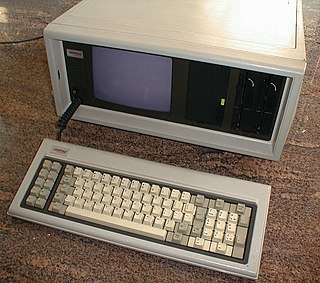Related Research Articles

A mainframe computer, informally called a mainframe or big iron, is a computer used primarily by large organizations for critical applications like bulk data processing for tasks such as censuses, industry and consumer statistics, enterprise resource planning, and large-scale transaction processing. A mainframe computer is large but not as large as a supercomputer and has more processing power than some other classes of computers, such as minicomputers, servers, workstations, and personal computers. Most large-scale computer-system architectures were established in the 1960s, but they continue to evolve. Mainframe computers are often used as servers.

A programmer, computer programmer or coder is an author of computer source code – someone with skill in computer programming.

In computing, a virtual machine (VM) is the virtualization or emulation of a computer system. Virtual machines are based on computer architectures and provide the functionality of a physical computer. Their implementations may involve specialized hardware, software, or a combination of the two. Virtual machines differ and are organized by their function, shown here:

A word processor is an electronic device for text, composing, editing, formatting, and printing.

IBM PC–compatible computers are technically similar to the original IBM PC, XT, and AT, all from computer giant IBM, that are able to use the same software and expansion cards. Such computers were referred to as PC clones, IBM clones or IBM PC clones. The term "IBM PC compatible" is now a historical description only, since IBM no longer sells personal computers after it sold its personal computer division in 2005 to Chinese technology company Lenovo. The designation "PC", as used in much of personal computer history, has not meant "personal computer" generally, but rather an x86 computer capable of running the same software that a contemporary IBM PC could. The term was initially in contrast to the variety of home computer systems available in the early 1980s, such as the Apple II, TRS-80, and Commodore 64. Later, the term was primarily used in contrast to Apple's Macintosh computers.

Apollo Computer Inc., founded in 1980 in Chelmsford, Massachusetts, by William Poduska and others, developed and produced Apollo/Domain workstations in the 1980s. Along with Symbolics and Sun Microsystems, Apollo was one of the first vendors of graphical workstations in the 1980s. Like computer companies at the time and unlike manufacturers of IBM PC compatibles, Apollo produced much of its own hardware and software.

Adam Osborne was a British author, software publisher, and computer designer who founded several companies in the United States and elsewhere. He introduced the Osborne 1, the first commercially successful portable computer.

A secretary, administrative assistant, executive assistant, personal secretary, or other similar titles is an individual whose work consists of supporting management, including executives, using a variety of project management, program evaluation, communication, and/or organizational skills within the area of administration. There is a diverse array of work experiences attainable within the administrative support field, ranging between internship, entry-level, associate, junior, mid-senior, and senior level pay bands with positions in nearly every industry, especially among white-collar careers.

The IBM PCjr was a home computer produced and marketed by IBM from March 1984 to May 1985, intended as a lower-cost variant of the IBM PC with hardware capabilities better suited for video games, in order to compete more directly with other home computers such as the Apple II and Commodore 64.
System Development Corporation (SDC) was a computer software company based in Santa Monica, California. Founded in 1955, it is considered the first company of its kind.

In software engineering, coupling is the degree of interdependence between software modules; a measure of how closely connected two routines or modules are; the strength of the relationships between modules. Coupling isn't binary but it's multi-dimensional.
The software industry includes businesses for development, maintenance and publication of software that are using different business models, mainly either "license/maintenance based" (on-premises) or "Cloud based". The industry also includes software services, such as training, documentation, consulting and data recovery. The software and computer services industry spends more than 11% of its net sales for Research & Development which is in comparison with other industries the second highest share after pharmaceuticals & biotechnology.

Apple Inc., originally Apple Computer, Inc., is a multinational corporation that creates and markets consumer electronics and attendant computer software, and is a digital distributor of media content. Apple's core product lines are the iPhone smartphone, iPad tablet computer, and the Macintosh personal computer. The company offers its products online and has a chain of retail stores known as Apple Stores. Founders Steve Jobs, Steve Wozniak, and Ronald Wayne created Apple Computer Co. on April 1, 1976, to market Wozniak's Apple I desktop computer, and Jobs and Wozniak incorporated the company on January 3, 1977, in Cupertino, California.

Larry LeRoy Constantine is an American software engineer, professor in the Center for Exact Sciences and Engineering at the University of Madeira Portugal, and considered one of the pioneers of computing. He has contributed numerous concepts and techniques forming the foundations of modern practice in software engineering and applications design and development.
International Business Machines (IBM) is a multinational corporation specializing in computer technology and information technology consulting. Headquartered in Armonk, New York, the company originated from the amalgamation of various enterprises dedicated to automating routine business transactions, notably pioneering punched card-based data tabulating machines and time clocks. In 1911, these entities were unified under the umbrella of the Computing-Tabulating-Recording Company (CTR).

In software engineering, structured analysis (SA) and structured design (SD) are methods for analyzing business requirements and developing specifications for converting practices into computer programs, hardware configurations, and related manual procedures.

Following the introduction of the IBM Personal Computer, or IBM PC, many other personal computer architectures became extinct within just a few years. It led to a wave of IBM PC compatible systems being released.
Advanced Computer Techniques (ACT) was a computer software company most active from the early 1960s through the early 1990s that made software products, especially language compilers and related tools. It also engaged in information technology consulting, hosted service bureaus, and provided applications and services for behavioral health providers. ACT had two subsidiaries of note, InterACT and Creative Socio-Medics.
Informatics General Corporation, earlier Informatics, Inc., was an American computer software company in existence from 1962 through 1985 and based in Los Angeles, California. It made a variety of software products, and was especially known for its Mark IV file management and report generation product for IBM mainframes, which became the best-selling corporate packaged software product of its time. It also ran computer service bureaus and sold turnkey systems to specific industries. By the mid-1980s Informatics had revenues of near $200 million and over 2,500 employees.
A word processor (WP) is a device or computer program that provides for input, editing, formatting, and output of text, often with some additional features.
References
- ↑ "Association of British Secretaries in America, Ltd". New York Companies. Retrieved September 1, 2014.
- 1 2 3 "Newest British Import – Girls for Secretarial Jobs". Rhinelander Daily News . Associated Press. November 21, 1960. p. 12.
- 1 2 Scot, Barbara (September 29, 1967). "Secretaries wanted across the Atlantic". The Glasgow Herald . p. 9.
- 1 2 3 4 Seebohm, Caroline (July 19, 1971). "English Girls in New York: They Don't Go Home Again". New York . pp. 34–38.
- ↑ "Paean: an ACT/Inter-ACT Communication". Computer History Museum . Retrieved August 31, 2014. Also "Paean An ACT/Inter-ACT Communication". Amazon. Retrieved August 31, 2014.
- ↑ Fishman, Katharine Davis (1981). The Computer Establishment (paperback 1982). New York: McGraw-Hill Book Company. p. 269.
- ↑ Haigh, Thomas (2004). An Interview with Oscar Schachter. Minneapolis: Charles Babbage Institute, University of Minnesota. pp. 7–8.
- ↑ Dvorak, John C. (August 19, 1985). "Tracking Down the IBM Songbook Department". InfoWorld . p. 64.
- ↑ Constantine, Larry L. (2001). The Peopleware Papers: Notes on the Human Side of Software (2nd ed.). Yourdon Press. p. 60.